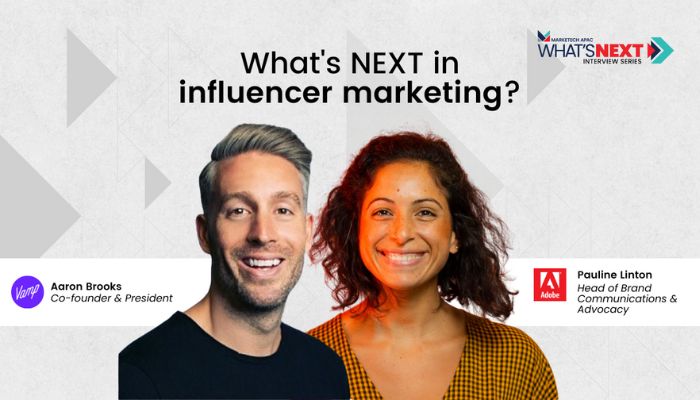Singapore – Influencer marketing has been gaining traction within the industry because of its ability to help brands get in front of new audiences and drive consumer engagement. Yet as a growing channel, it’s inevitable that marketers will still have to contend with the challenges of new platforms, new trends across social and evolving audience interests.
As part of MARKETECH APAC’s ‘What’s NEXT 2023: Interview Series’, Aaron Brooks, co-founder and president of influencer marketing platform Vamp and Pauline Linton, head of brand communications and advocacy at Adobe shared their insights on how brands could face these challenges in the inaugural episode of What’s NEXT’s interview series. In the conversation, they provide an insider’s perspective on how the influencer marketing space is evolving, emerging key trends, as well as what’s in store for the industry moving into 2023.
How has influencer marketing evolved from a tech enabler and top brand’s perspective?
Kicking off the interview, Brooks shared how Vamp came into existence. Starting from content generation and using social platforms to help brands source creative, Vamp later developed into an influencer marketing platform designed to make collaborating with influencers simpler and easier.
“It was an opportunity to build a single solution that would just simplify that whole process. We wanted to simplify campaign management workflow, facilitate direct communication between collaborators, and build a proprietary algorithm that would help match-make brands to creators. Of course, you’ve got to have access to first-party data to be able to track performance and campaign ROAS, as well. So really, that’s where we’ve been focusing our efforts,” Brooks explained.
Coming from the end user’s perspective, Linton shared how Adobe’s approach to influencer marketing has evolved over the past years. “There was never really an influencer marketing programme when I was agency-side or when I first started at Adobe. I think influencers were always seen as ‘how are we going to continue to amplify’ or just as another distribution channel for our marketing campaigns,” she commented.
Linton also added that their use of influencers has evolved as the market has changed, and as their communications got more sophisticated. She said, “We realised the value of social media in our broader comms programme and how important influencers were to [localise] content creation for us across Asia Pacific.”
The value of influencers in the ideation stage
Influencers are valued for their ability to amplify a brand’s marketing initiatives. But as influencers are now seen more as ‘creators’, the multiplier effect of having them involved in both the ideation phase, as well as being the means to generate mass-awareness of the message, is something we expect to see more of.
Linton gives a nod to this – and references how Adobe’s campaign approach has changed over the years from having influencers simply boost messages to audiences, to involving them in the ideation and planning stages.
“We’ve evolved our strategy from influencers being put on every campaign to extend our campaigns as amplifiers, to really bringing them in at the very ideation and planning stage, and thinking about them more [as] content generators and ideators, and not just to amplify our programmes,” she said.
Moreover, she said that giving influencers creative control could ‘surprise’ marketers. “We started off as being really protective with our brand, and then we realised that, actually, influencers had better ideas than we did, so we’ve learnt to relinquish some of that creative control.”
On the other hand, Brooks also mentioned four key things that brands should consider when activating their influencer marketing strategies. These are (1) defining why your brand wants to work with creators, (2) treating influencers like the content experts they are, (3) testing and learning by creating various content to find the right format and channels, and (4) treating creators as brand ambassadors.
“We’re seeing now, more than ever, brands building up relationships with creators, and then using that squad for multiple and repeat activations. Not just activating on a project-by-project basis, but having a long-term view of creator and influencer marketing as well,” he added.
‘What’s NEXT’ for the influencer marketing space?
The coming years can be unpredictable for the marketing industry. That said, Brooks and Linton also gave their insights into where the influencer marketing industry is heading, including indications of some of the plans Vamp and Adobe have moving forward.
According to Brooks, influencer marketing has already reached a point where it’s already become a mainstay within the marketing mix. He added, “Once an emerging channel, it really has gained acceptance as a performance marketing channel.”
Speaking of his experience, Brooks mentioned that brands want access to better data, as they want to understand how their organic performance is creating impact, as a means to justify budget spend. To address this, Brooks said that Vamp continues to evolve its technology to prioritise their analytics capability, and providing deeper insights.
Of course, the talk on the future of marketing would not be complete without reference to the metaverse, and VR/AR technologies. To this, Linton mentioned that Adobe is thinking about mixed mediums or realities where they can create different modes of engagement with influencers.
“The insight that we get from influencers [are] really shaping the way we approach 2023. There’s a lot of exciting stuff to look forward to,” Linton concluded.
There’s certainly a lot to look forward to in the marketing industry for 2023. From a tech enabler and top brand’s perspective, you can hear more influencer marketing insights from Brooks and Linton by watching the full interview HERE.

